Articles
- Page Path
- HOME > J Korean Acad Nurs > Volume 41(5); 2011 > Article
-
Original Article
- A Social Network Analysis of Research Topics in Korean Nursing Science
- Soo-Kyoung Lee, Senator Jeong, Hong-Gee Kim, Young-Hee Yom
-
Journal of Korean Academy of Nursing 2011;41(5):623-632.
DOI: https://doi.org/10.4040/jkan.2011.41.5.623
Published online: October 31, 2011
1Researcher, Biomedical Knowledge Engineering Laboratory, Seoul National University, Seoul, Korea.
2Associate Professor, School of Dentistry, Seoul National University, Seoul, Korea.
3Professor, Department of Nursing, Chung-Ang University, Seoul, Korea.
- Address reprint requests to: Yom, Young-Hee. Department of Nursing, Chung-Ang University, 221 Heukseok-dong, Dongjak-gu, Seoul 156-756, Korea. Tel: +82-2-820-5700, Fax: +82-2-824-7961, yhyom@cau.ac.kr
• Received: January 24, 2011 • Accepted: October 24, 2011
© 2011 Korean Society of Nursing Science
Abstract
-
Purpose
- This study was done to explore the knowledge structure of Korean Nursing Science.
-
Methods
- The main variables were key words from the research papers that were presented in the Journal of Korean Academy of Nursing and journals of the seven branches of the Korean Academy of Nursing. English titles and abstracts of the papers (n=5,936) published from 1995 through 2009 were included. Noun phrases were extracted from the corpora using an in-house program (BiKE Text Analyzer), and their co-occurrence networks were generated via a cosine similarity measure, and then the networks were analyzed and visualized using Pajek, a Social Network Analysis program.
-
Results
- With the hub and authority measures, the most important research topics in Korean Nursing Science were identified. Newly emerging topics by three-year period units were observed as research trends.
-
Conclusion
- This study provides a systematic overview on the knowledge structure of Korean Nursing Science. The Social Network Analysis for this study will be useful for identifying the knowledge structure in Nursing Science.
This work was supported by the Korean Research Foundation Grant funded by the Korean Government (KRF-2008-562-D00035).
- 1. Batagelj V, Mrvar A. Pajek: Program for analysis and visualization of large networks. Timeshift-The World in Twenty-Five Years: Ars Electronica. 2004;Retrieved January 24, 2011. 242–251. from http://90.146.8.18/en/archiv_files/20041/FE_2004_batageljmrvar_en.pdf.
- 2. Barrett EM. What is nursing science? Nursing Science Quarterly. 2002;15:51–60.ArticlePubMed
- 3. Boyack KW, Klavans R, Börner K. Mapping the backbone of science. Scientometrics. 2005;64:351–374.ArticlePDF
- 4. Effken J, Gephart S, Bianchi D, Verran J. Correlations of nursing communication network metrics with patient outcomes. Annual Symposium proceedings/AMIA Symposium. AMIA Symposium. 2010;2010:197–201.
- 5. Estabrooks CA, Winther C, Derksen L. Mapping the field: A bibliometric analysis of the research utilization literature in nursing. Nursing Research. 2004;53:293–303.ArticlePubMed
- 6. Goh KI, Cusick ME, Valle D, Childs B, Vidal M, Barabási AL. The human disease network. Proceedings of the National Academy of Sciences of the United States of America. 2007;104:8685–8690. doi: 10.1073/pnas.0701361104.ArticlePubMedPMC
- 7. He Q. Knowledge discovery through co-word analysis. Library Trends. 1999;48(1):133–159.
- 8. Jang SO. Analysis of research papers published in the Journal of Korean Academy of Nursing by the classification of knowing in nursing. Journal of Korean Academy of Nursing. 2005;35:206–212.PubMed
- 9. Jeong S, Kim HG. Intellectual structure of biomedical informatics reflected in scholarly events. Scientometrics. 2010;85:541–551.ArticlePDF
- 10. Jeong S, Lee SK, Kim HG. Knowledge structure of Korean medical informatics: A social network analysis of articles in journal and proceedings. Healthcare Informatics Research. 2010;16:52–59.ArticlePubMedPMC
- 11. Kang HC. Last 3 years (1999-2001) Journal of nursing for the use of statistical techniques for analysis. Journal of Korean Academy of Nursing. 2002;32:929–935.
- 12. Kim JI, Park SM, Park HS, Chung CW, Ahn SH. Analysis of published papers and their keywords in the Korean Journal of Women Health Nursing (2003-2006). Korean Journal of Women Health Nursing. 2007;13:51–59.ArticlePDF
- 13. Kim SJ, Kim KB, Yi MS, Lee KJ, Ahn YH, Kim HS, et al. The trends of nursing research in the journals of seven branches of the Korean Academy of Nursing. Journal of Korean Academy of Nursing. 2002;32:114–130.ArticlePDF
- 14. Kleinberg J. Authoritative sources in a hyperlinked environment. Journal of the ACM. 1999;46:604–632.Article
- 15. Lee MA, Yom YH. A comparative study of patients' and nurses' perceptions of the quality of nursing services, satisfaction and intend to revisit the hospital: A questionnaire survey. International Journal of Nursing Studies. 2007;44:545–555.ArticlePubMed
- 16. McCloskey Dochterman J, Bulechek G. Nursing interventions classification (NIC). 2004;4th ed.St. Louis, MO, Mosby.
- 17. Park JS, Park CJ. An analysis of nursing research on pain reported in Korea from 1970 to 1994. Journal of Korean Academy of Nursing Administration. 1995;25:30–44.ArticlePDF
- 18. Roh KH. A review of the trends of journal research on dementia and nursing interventions for demented elders. Journal of Korean Academy of Community Health Nursing. 2008;19:300–309.
- 19. Salton G. Developments in automatic text retrieval. Science. 1991;253(5023):974–980.ArticlePubMed
- 20. Scott J. Social network analysis. Sociology. 1988;22(1):109–127. doi: 10.1177/0038038588022001007.ArticlePDF
- 21. Seomun GA, Koh MS, Kim IA. Classification of keywords of the papers from the Journal of Korean Academy of Nursing Administration (2002-2006). Journal of Korean Academy of Nursing Administration. 2007;13:118–122.
- 22. Shin HS, Hyun MS, Ku MO, Cho MO, Kim SY, Jeong JS, et al. Analysis of research papers published in the Journal of the Korean Academy of Nursing-focused on research trends, intervention studies, and level of evidence in the research. Journal of Korean Academy of Nursing. 2010;40:139–149.ArticlePubMed
- 23. Sohng KY, Kim JI, Choi DW, Kim AK, Chaung SK, Kim KH, et al. Research trends in the Journal of Korean Academy of Fundamental Nursing. Journal of Korean Academy of Fundamentals of Nursing. 2008;15:262–273.
- 24. Suh YO, Park JS, Yang JH, Kim HW, Suk MH, Shin HS, et al. Analysis of research papers published in the Journal of Korean Academy of Nursing. Journal of Korean Academy of Nursing. 2007;37:1013–1019.ArticlePubMedPDF
- 25. Wilkinson DM, Huberman BA. A method for finding communities of related genes. Proceedings of the National Academy of Sciences of the United States of America. 2004;101:Suppl 1. 5241–5248. doi: 10.1073/pnas.0307740100.ArticlePubMedPMC
REFERENCES
Figure & Data
REFERENCES
Citations
Citations to this article as recorded by 

- Advancements in simulation-based nursing education: Insights from a bibliometric analysis of temporal trends
Minji Mun, Minsung Kim, Kyungmi Woo
Nurse Education Today.2025; 151: 106719. CrossRef - Topics and Trends in Neonatal Family-Centered Care
In Young Cho, Cho Hee Kim
CIN: Computers, Informatics, Nursing.2025;[Epub] CrossRef - Exploring the Knowledge Structures of Korean and International Nursing Research on Premature Infants Using Text Network Analysis
Myeong Seon Lee, Seonah Lee
CIN: Computers, Informatics, Nursing.2024; 42(2): 109. CrossRef - Natural Language Processing Application in Nursing Research
Minji Mun, Aeri Kim, Kyungmi Woo
CIN: Computers, Informatics, Nursing.2024; 42(12): 889. CrossRef - Identifying Latent Topics and Trends in Premature Infant–Related Nursing Studies Using a Latent Dirichlet Allocation Method
Myeong Seon Lee, Seonah Lee
CIN: Computers, Informatics, Nursing.2023; 41(12): 957. CrossRef - Research trends related to problematic smartphone use among school-age children including parental factors: a text network analysis
Eun Jee Lee
Child Health Nursing Research.2023; 29(2): 128. CrossRef - Analysis of School Commuting Safety and Accident Trend by School Level: Text Network Analysis and Topic Modeling
Beomjun Kim, Gwanjun Kim, Inseon Park
Fire Science and Engineering.2023; 37(4): 60. CrossRef - Trends of Nursing Research on Accidental Falls: A Topic Modeling Analysis
Yeji Seo, Kyunghee Kim, Ji-Su Kim
International Journal of Environmental Research and Public Health.2021; 18(8): 3963. CrossRef - An Identification of the Knowledge Structure on the Resilience of Caregivers of People with Dementia using a Text Network Analysis
Eun Young Kim, Sung Ok Chang
Journal of Korean Gerontological Nursing.2021; 23(1): 66. CrossRef - Analysis of research on metabolic syndrome in cancer survivors using topic modeling and social network analysis
Ji-Su Kim, Hyejin Kim, Eunkyung Lee, Yeji Seo
Science Progress.2021;[Epub] CrossRef - Text network analysis of research topics and trends on global health nursing literature from 1974 ‐2017
Hye Sun Hong, Soo‐Kyoung Lee
Journal of Advanced Nursing.2021; 77(3): 1325. CrossRef - Identification of the Knowledge Structure of Cancer Survivors’ Return to Work and Quality of Life: A Text Network Analysis
Kisook Kim, Ki-Seong Lee
International Journal of Environmental Research and Public Health.2020; 17(24): 9368. CrossRef - Knowledge Structure of Nursing Studies on Heart Failure Patients in South Korea through Text Network Analysis
Seang Ryu, Hyunyoung Park, Yun-Hee Kim
Korean Journal of Adult Nursing.2020; 32(4): 409. CrossRef - Analysis of Research on Nurses’ Job Stress Using Network Analysis
Young-Su Kim, Soo-Kyoung Lee
Western Journal of Nursing Research.2019; 41(3): 338. CrossRef - Identification of Knowledge Structure of Pain Management Nursing Research Applying Text Network Analysis
Chan Sook Park, Eun-Jun Park
Journal of Korean Academy of Nursing.2019; 49(5): 538. CrossRef - Using Text Network Analysis for Analyzing Academic Papers in Nursing
Chan Sook Park
Perspectives in Nursing Science.2019; 16(1): 12. CrossRef - A Literature Review of the Studies on Cultural Competency of Nurses and Nursing Students in Korea
Min-A Kim, So-Eun Choi
Journal of Korean Academy of Community Health Nursing.2018; 29(4): 450. CrossRef - Co-occurrence Network Analysis of Keywords in Geriatric Frailty
Youngji Kim, Soong-nang Jang, Jung Lim Lee
Journal of Korean Academy of Community Health Nursing.2018; 29(4): 429. CrossRef - The Network Analysis of Nursing Diagnoses for Children Admitted in Pediatric Units Determined by Nursing Students
Mikyung Moon
Journal of Health Informatics and Statistics.2017; 42(3): 223. CrossRef - A Comparison of Hospice Care Research Topics between Korea and Other Countries Using Text Network Analysis
Eun-Jun Park, Youngji Kim, Chan Sook Park
Journal of Korean Academy of Nursing.2017; 47(5): 600. CrossRef - Social Network Analysis on Mapping the Knowledge Structure of Dementia Research
Jung-Hee Han, Young-Hee Yom
Journal of Korean Gerontological Nursing.2017; 19(2): 69. CrossRef - Analysis of Students Experience related of Nursing Management Clinical Practice: Text Network Analysis Method
Kyeong Hwa Kang, Soyoung Yu
Journal of Korean Academy of Nursing Administration.2016; 22(1): 80. CrossRef - Exploratory Study of Publicness in Healthcare Sector through Text Network Analysis
Hye Sook Min, Chang-Yup Kim
Health Policy and Management.2016; 26(1): 51. CrossRef - The Analysis of Knowledge Structure using Co-word Method in Quality Management Field
Man-Hee Park
Journal of the Korean society for quality management.2016; 44(2): 389. CrossRef - Social Network Analysis of author's interest area in Journals about Computer
Ju-Yeon Lee, Yoo-Hyun Park
Journal of the Korea Institute of Information and Communication Engineering.2016; 20(1): 193. CrossRef - Knowledge Structure of the Korean Journal of Occupational Health Nursing through Network Analysis
Sun Young Kwon, Eun Jung Park
Korean Journal of Occupational Health Nursing.2015; 24(2): 76. CrossRef - A Critical Discussion on the Academic Fundamentals and the Missions of Child Health Nursing
Kap-Chul Cho
Child Health Nursing Research.2015; 21(4): 311. CrossRef - Trends of research articles in the <i>Korean Journal of Medical Education</i> by social network analysis
Hyo Hyun Yoo, Sein Shin
Korean Journal of Medical Education.2015; 27(4): 247. CrossRef - Visualization of e-Health Research Topics and Current Trends Using Social Network Analysis
Youn-Jung Son, Senator Jeong, Byeong-Gwon Kang, Sun-Hyung Kim, Soo-Kyoung Lee
Telemedicine and e-Health.2015; 21(5): 436. CrossRef - Development of u-Health standard terminology and guidelines for terminology standardization
Soo-Kyoung Lee
Journal of the Korea Academia-Industrial cooperation Society.2015; 16(6): 4056. CrossRef - A Study on the Factors Influencing Semantic Relation in Building a Structured Glossary
Sun-Young Kwon
Journal of the Korean Society for Library and Information Science.2014; 48(2): 353. CrossRef - Social network analysis on consumers' seeking behavior of health information via the Internet and mobile phones
Ji-Young An, Haeran Jang, Jinkyung Paik
Journal of Korea Multimedia Society.2014; 17(8): 995. CrossRef - Social Network Analysis of Elders' Health Literacy and their Use of Online Health Information
Haeran Jang, Ji-Young An
Healthcare Informatics Research.2014; 20(3): 216. CrossRef - Application of Social Network Analysis to Health Care Sectors
Hae Lan Jang, Young Sung Lee, Ji-Young An
Healthcare Informatics Research.2012; 18(1): 44. CrossRef - Book Review: Social Networks and Health: Models, Methods, and Applications
Ji-Young An
Healthcare Informatics Research.2012; 18(4): 287. CrossRef
A Social Network Analysis of Research Topics in Korean Nursing Science
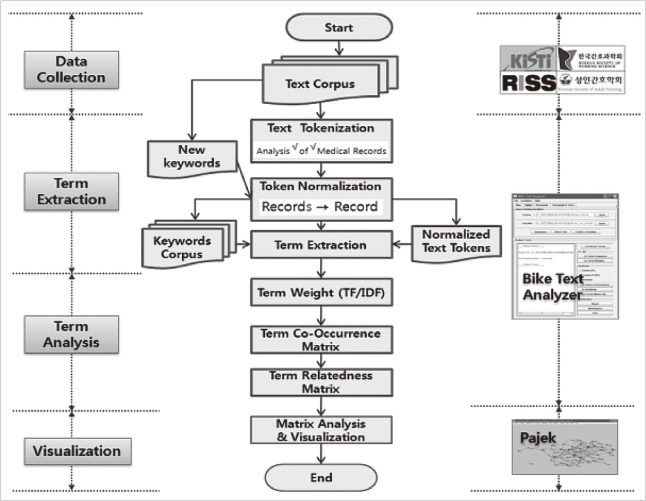
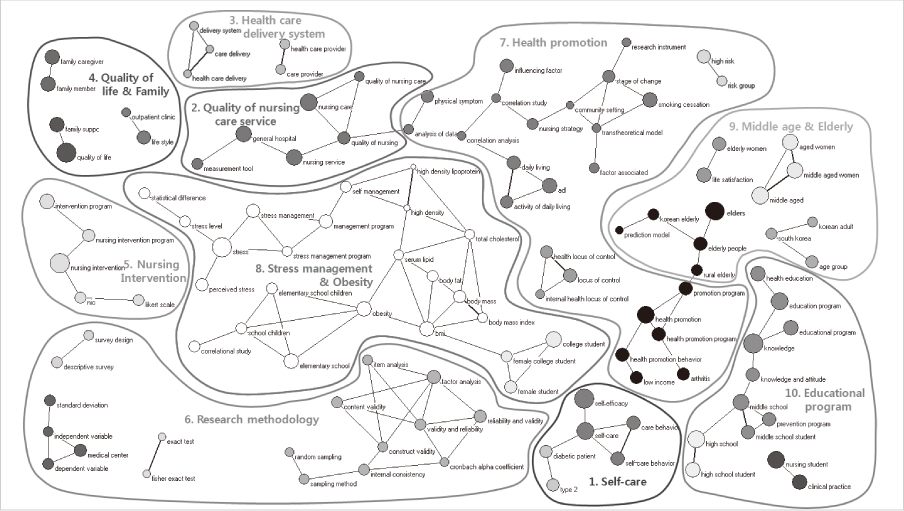
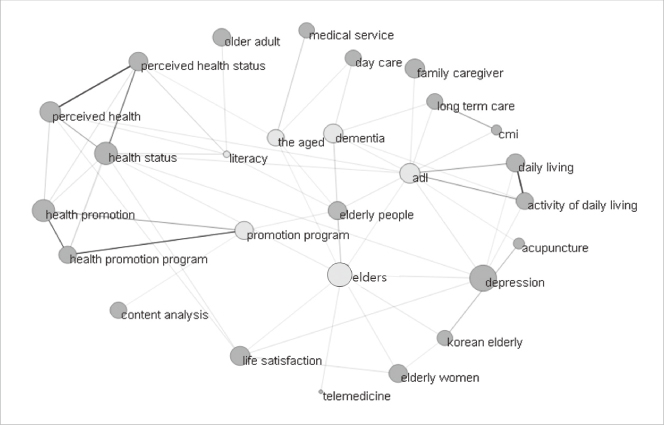
Figure 1
The process of analysis of research topics in korean nursing science.
Figure 2
Topic clustering (Tf 10; n=126; cosine≥0.15; k-component1; component=9).
Figure 3
The kth nearest neighbors analysis of 'elderly people' topic.
Figure 1
Figure 2
Figure 3
A Social Network Analysis of Research Topics in Korean Nursing Science
Research Journals and Information Service (URL) (N=5,936)
*Log-in required.
Newly Emerging Research Topics in Korean Nursing Science (Top 2% of frequently occurring terms in a 3-year phase)
Table 1
Research Journals and Information Service (URL) (N=5,936)
*Log-in required.
Table 2
Newly Emerging Research Topics in Korean Nursing Science (Top 2% of frequently occurring terms in a 3-year phase)
 KSNS
KSNS
 E-SUBMISSION
E-SUBMISSION



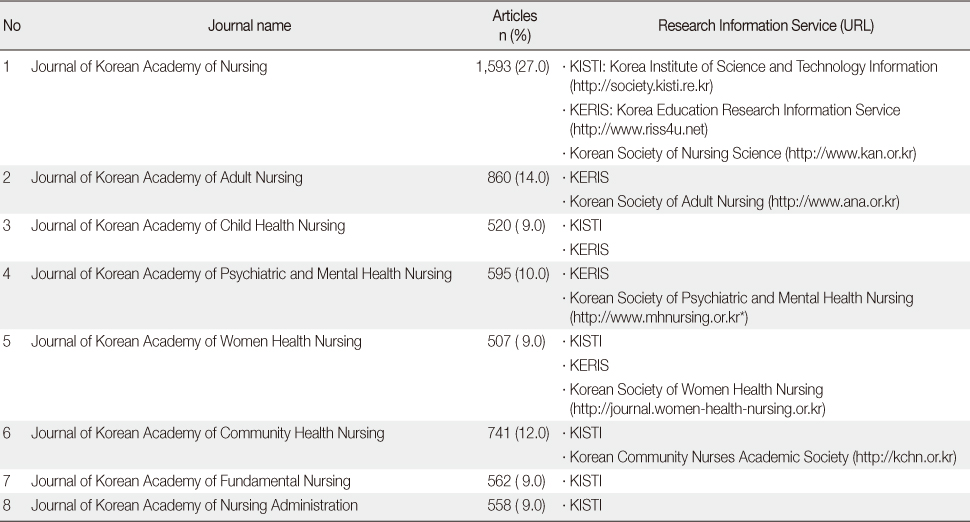
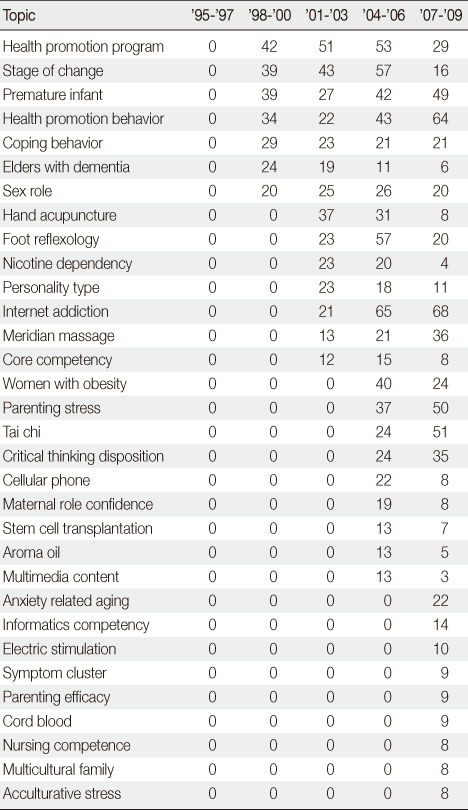
 Cite
Cite

